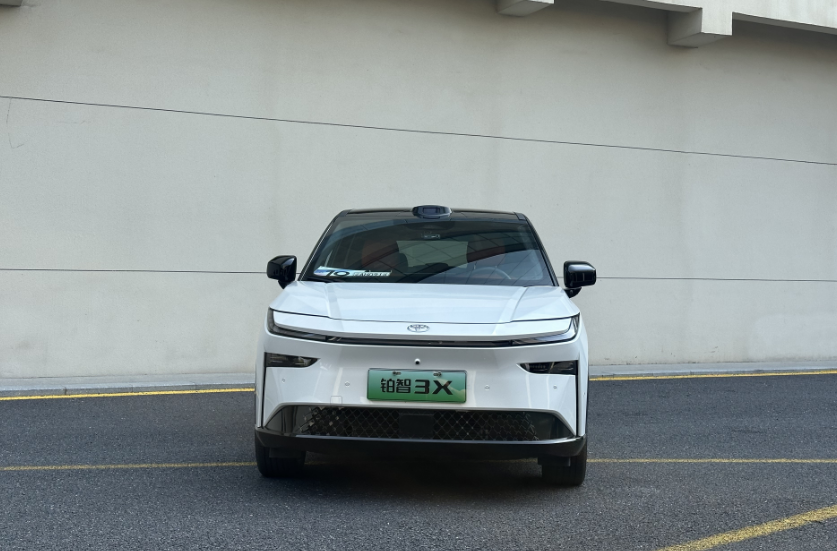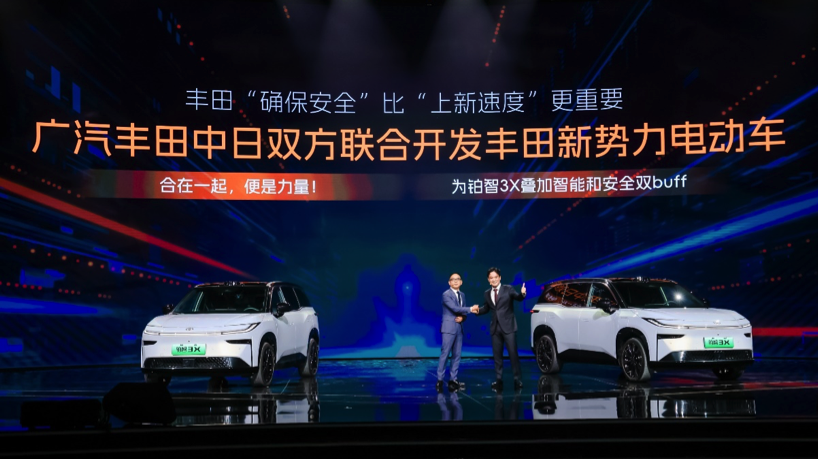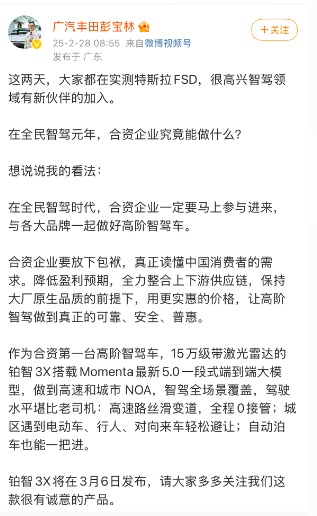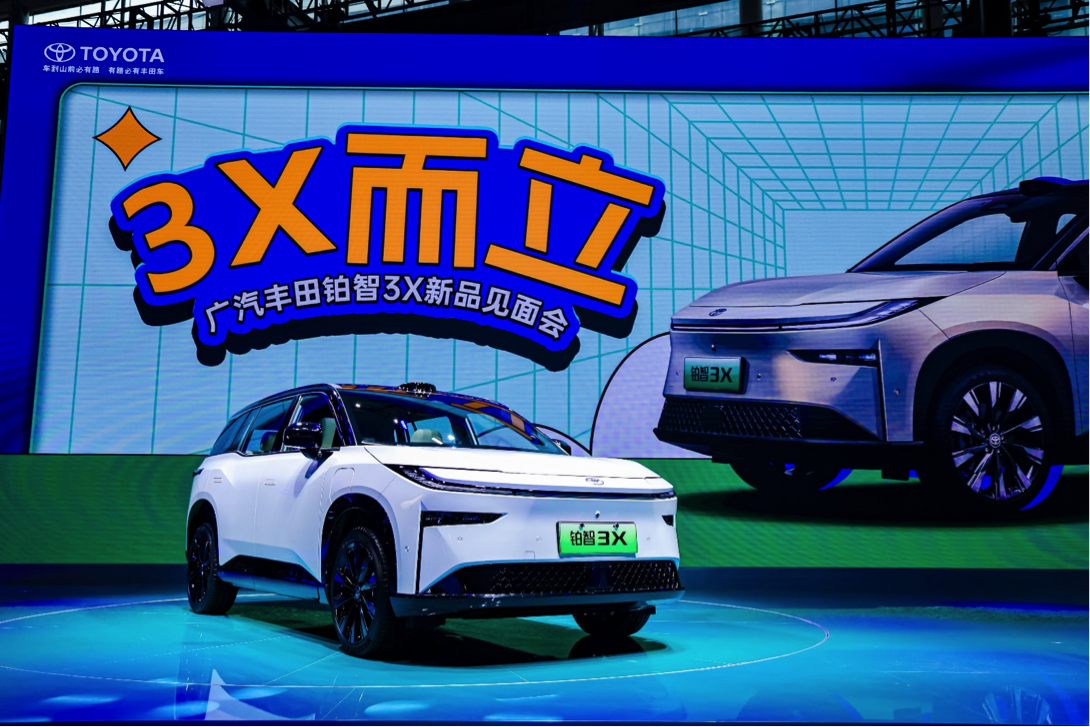
As Toyota has been fully committed to strengthening localized R&D and giving the Chinese team high decision-making power, they have begun to catch up in the field of intelligence. Compared with the popularity of the popular brands and new forces booths in the past two years, Toyota's bZ/Bozhi series was the object of scrambling for photos by major media at the Shanghai Auto Show Media Day a week ago.
When power batteries "do not catch fire or explode" become mandatory national standards, and when intelligent driving assistance systems are put under the tight control of "combined driving assistance", the Chinese auto market is experiencing the most stringent safety test in history. This may be the turning point in the fate of "new forces" and "traditional automakers" in this battle.

Recently, we test-drove the latest product of Chinese innovation and Toyota standards, the GAC Toyota Platinum 3X, in Jiaxing. This car proves that in the fiercely competitive 150,000-class pure electric SUV market, safety and intelligence are never choices.

The design philosophy of the Bozhi 3X is a delicate balance between functional aesthetics and oriental connotations. The front face outlines a sense of the future with minimalist curves, and the split headlights are embedded with 240 LED beads. The 7 sets of dynamic light language are like stars flowing at the moment of unlocking. This expression of hiding technology in restraint is exactly Toyota's new interpretation of design in the pure electric era. On the side of the body, the vigorous waistline extends from the front wheel arch to the taillight, and together with the 18° approach angle and 25° departure angle, it outlines the wild genes of the SUV, and the 0.27cd drag coefficient is a perfect compromise between aerodynamics and styling aesthetics.

Open the door, and the design theme of migratory birds returning to their nests is transformed into a touchable warmth. On the dashboard and door panels, the lines of square and round form an embracing layout. The collision of deep space gray soft package material and moon white stitching creates a home-like sense of relaxation. The hidden metal trim in the air-conditioning outlet design divides the visual center of gravity with a golden ratio of 0.618. This ingenuity of combining oriental aesthetics with modern craftsmanship is rare in joint venture models. And when the fingertips pass over the 14.6-inch floating central control screen, the smooth interaction brought by the 8155 chip and the smart cockpit composed of the four-tone zone voice recognition system instantly pull people back to the digital age.

In terms of space, the 4.6-meter-long body hides a 2765mm wheelbase, and the rear legroom reaches an astonishing 1145mm. The longitudinal space is large enough for a 7-year-old child to walk upright, which makes traditional B-class cars pale in comparison. Even better is the space transformation capability. The front seats are folded down to form a 1.8-meter flat space, which can be connected with the back row to form a 3-meter long sleeping area. With the unique rear foldable small table in the same class, it can be transformed into a mobile office. The design of 30 storage spaces in the whole car further demonstrates the ingenuity of engineers, 21 of which are located in the golden area within the reach of the driver, and even the wireless charging plate is equipped with a cooling fan - this often overlooked detail is precisely the uniqueness of GAC Toyota engineers.

The interactive system built with the 14.6-inch floating central control screen and the 8155 chip is eye-catching enough, but what really makes people deeply impressed is the obsession with safety hidden under the smart cockpit. The emergency power-off button embedded in the central armrest box is not a decoration. This physical switch and the dual redundant braking system form the last line of defense. Even if the main braking system fails, the dual protection of iBooster and ESP can still provide sufficient braking force, and the dual backup design of the brake booster power supply ensures that the vehicle can stop steadily in any emergency. This kind of engineering thinking that maximizes safety redundancy can be called a dimensionality reduction strike in the 100,000-level pure electric market.

Passive safety is Toyota's bottom line that it will never compromise on. In a frame made of 72% high-strength steel, 1500MPa hot-formed steel wraps the passenger compartment like armor. This material, commonly used in armored vehicles, accounts for 30%, forming a solid protective barrier at key locations such as the A-pillar and B-pillar. When the enveloping cage-shaped cabin encounters a 90° side column collision, the combination of high-strength steel and hot-formed steel strictly controls the body deformation within a safe threshold. When the test vehicle hits a simulated obstacle at a speed of 30km/h, the high-level welding process and large-area anti-corrosion coating work together to deform the body's A-pillar by only 3.2mm, far below the industry average of 5mm.

The performance of the intelligent driving assistance system is even more subversive. The perception matrix composed of laser radar and 11 high-definition cameras fully demonstrates the decision-making logic of Momenta's one-stage end-to-end large model. The system's recognition accuracy of fuzzy lane lines reaches the centimeter level. It can detect and perform anthropomorphic execution for motor vehicles and non-motor vehicles that travel sideways when turning left or right. It will neither rush around like a fool nor be overly courteous and affect traffic efficiency. The only thing that is almost wrong is that when there are large heavy trucks in adjacent lanes on urban roads, the system is not brave enough to overtake the truck decisively because of doubts about the truck's trajectory. However, this is also a reaction to the concept of "safety first". This ability to convert hardware performance into actual scene adaptability stems from the eight safety requirements Toyota has implanted in vehicles.

The parking safety performance is also remarkable. Facing the extreme side position with the left pillar close to the car, the 360-degree surround camera and ultrasonic radar work together to complete the parking with high precision.
Battery safety protection also demonstrates Toyota's car-making philosophy. When Lynk & Co 900 claimed that it was the first model to meet the new power battery regulations, the battery cells of the Bozhi 3X had already fully met the new national standard for power battery safety in 2026. In the bottom ball impact test, the cell intrusion was controlled within 0.5mm, which is only equivalent to the diameter of a pencil tip. Behind this is a protective network built by more than 140 high-cost chip fuses and a unique dispensing process.
In the simulated battery pack thermal runaway test, a single cell failure did not cause any heat spread, and the temperature of adjacent cells was always below the safety threshold of 60°C. High-strength steel + hard foam is used to fill the gaps between the cells to ensure that the cells are not damaged.
When sitting in the back seat, the foldable small table and the YAMAHA sound system create the atmosphere of a mobile living room. The unique "Grow with Me" height scale line in the same class is silently guarding the travel safety of every family. This model, with a starting price of only 109,800 yuan, interprets Toyota's determination to transform with product strength that goes beyond the price dimension. While fellow travelers are still discussing cost-effectiveness, the Bozhi 3X has redefined the new safety standard of the 100,000 yuan pure electric market with 16 major safety items and nearly 100 safety considerations.


